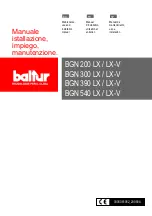
recharges your body with static electricity (for example; DO
NOT move or shuffle your feet, DO NOT touch un-
grounded objects, etc.).
4. If you touch ungrounded objects (and recharge your body
with static electricity), firmly touch furnace again before
touching control or wires.
5. Use this procedure for installed and uninstalled (un-
grounded) furnaces.
6. Before removing a new control from its container, dis-
charge your body’s electrostatic charge to ground to protect
the control from damage. If the control is to be installed in
a furnace, follow items 1 through 5 before bringing the
control or yourself into contact with the furnace. Put all
used AND new controls into containers before touching
ungrounded objects.
7. An ESD service kit (available from commercial sources)
may also be used to prevent ESD damage.
LOCATION
I.
GENERAL
CAUTION:
Do not install furnace in a corrosive or
contaminated atmosphere. Make sure all combustion and
circulating air requirements are met, in addition to all
local codes and ordinances.
Do not use this furnace during construction when adhe-
sives, sealers, and/or new carpets are being installed. If
the furnace is required during construction, use clean
outside air for combustion and ventilation. Compounds of
chlorine and fluorine when burned with combustion air
form acids which cause corrosion of the heat exchangers
and metal vent system. Some of these compounds are
found in paneling and dry wall adhesives, paints, thin-
ners, masonry cleaning materials, and many other sol-
vents commonly used in the construction process.
Excessive exposure to contaminated combustion air will
result in safety and performance related problems.
WARNING:
DO NOT install the furnace on its back or
sides. Safety control operation will be adversely affected.
A failure to follow this warning can cause a fire, personal
injury, or death.
This furnace must be installed so the electrical components are
protected from water.
Locate furnace as close to the chimney/vent and as near the center
of the air distribution system as possible. The furnace should be
installed as level as possible.
Provide ample space for servicing and cleaning. Always comply
with the minimum fire protection clearances shown on the unit
rating plate. This furnace shall not be installed directly on
carpeting, tile, or any combustible material other than wood
flooring. The furnace may be installed on combustible flooring
when installed with the accessory downflow subbase, which is
available from your distributor or branch when required.
II.
LOCATION RELATIVE TO COOLING EQUIPMENT
The cooling coil must be installed parallel with or on the
downstream side of the unit to avoid condensation in the heat
exchangers. When installed parallel with a furnace, dampers or
other means used to control the flow of air must prevent chilled air
from entering the unit. If the dampers are manually operated, they
must be equipped with means to prevent operation of either unit
unless the damper is in the full-heat or full-cool position.
III.
HAZARDOUS LOCATIONS
WARNING:
When furnace is installed in a residential
garage, it must be installed so that burners and ignition
sources are located a minimum of 18 in. above floor. The
furnace must be located or protected to avoid physical
damage by vehicles. When furnace is installed in a public
garage, airplane hangar, or other building having a
hazardous atmosphere, unit must be installed in accor-
dance with requirements of National Fire Protection
Association, Inc.
Air For Combustion And Ventilation
Provisions for adequate combustion and ventilation air must be
provided in accordance with Section 5.3 of the NFGC, Air for
Combustion and Ventilation, or applicable provisions of the local
building codes.
Canadian installations must be installed in accordance with NSC-
NGPIC and all authorities having jurisdiction.
CAUTION:
Air for combustion must not be contami-
nated by halogen compounds, which include fluoride,
chloride, bromide, and iodide. These elements are found
in aerosol sprays, detergents, bleaches, cleaning solvents,
salts, air fresheners, and other household products.
CAUTION:
The operation of exhaust fans, kitchen ven-
tilation fans, clothes dryers, or fireplaces could create a
NEGATIVE PRESSURE CONDITION at the furnace.
Make-up air MUST be provided for the ventilation
devices, in addition to that required by the furnace.
All fuel-burning equipment must be supplied with air for combus-
tion of the fuel. Sufficient air MUST be provided to ensure there
will not be a negative pressure in the equipment room or space. In
addition, a positive seal MUST be made between the furnace
cabinet and the return-air duct to avoid pulling air from the burner
area and blocked vent safeguard opening.
The requirements for combustion and ventilation air depend upon
whether the furnace is located in an unconfined or confined space.
IV.
UNCONFINED SPACE
An unconfined space has volume of at least 50 cu ft for each 1000
Btuh of total input for all appliances (such as furnaces, clothes
dryers, water heaters, etc.) in the space.
A93044
18-IN. MINIMUM
TO BURNERS
—4—





































